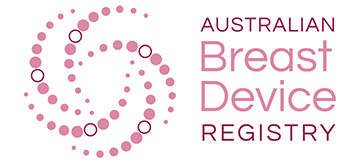What is the ABDR?
The Australian Breast Device Registry (ABDR) is a Commonwealth-funded Monash University-led health initiative that records health data relating to breast device surgery. The registry has the purpose to monitor the long-term safety and performance of breast devices, to identify and report on possible trends and complications and the quality of surgery involving breast implants, breast tissue expanders and acellular dermal matrices and other meshes associated with breast devices.
The ABDR:
- Provides progressive reports, using validated data, to key stakeholders such as surgeons/clinicians, hospitals, the TGA (Therapeutic Goods Administration) and Department of Health
- Helps give patients peace of mind that devices are being tracked and facilitates quicker communication in the event of a hazard alert
- Is the first registry in the world to have the support of all surgical craft groups: The Australian Society of Plastic Surgeons (ASPS), Australasian College of Cosmetic Surgery and Medicine (ACCSM) and Breast Surgeons of Australian & New Zealand Inc. (BreastSurgANZ) to develop and implement a registry
- Is conducted by Monash University’s School of Public Health & Preventive Medicine
- Is an opt-out registry to maximise data representation
About Data Collected by the ABDR
Thousands of Australians undergo breast device surgery every year. Breast devices are used in cosmetic and reconstructive surgeries, such as after a mastectomy, and to correct congenital anomalies.
Monash University leads the ABDR in Australia, capturing information about breast devices within a highly secured database. The registry independently generates objective, validated data for reports to stakeholders, such as surgeons, the Department of Health and the TGA (Therapeutic Goods Administration). Reports may include information on best health outcomes and surgical practice, where treatment gaps may exist and its effect on patient outcomes, and facilitates quality improvement.
The ABDR holds a record of device details, which patients can access upon request, such as when changing surgeons. The registry may help provide patients and their loved ones peace of mind that the safety of devices are being tracked long-term.
The ABDR collects information about breast devices using a simple Data Collection Form (DCF) completed by surgeons at the time of surgery. The aim is to collect information about all surgical procedures involving breast implants, breast tissue expanders and acellular dermal matrices (or similar) undertaken nationally. This include insertions, revisions of devices already in place, and explants (device removal) with and without a replacement device.
Information from the DCFs generates a powerful set of accurate and validated data that can be analysed and reported to individual surgeons, hospitals, the Department of Health, TGA and other key stakeholders. The ABDR facilitates, for the first time, information on device failure rates, complications and revision rates of procedures involving breast devices nationally.
Additional to data collected at the time of surgery and revision surgery, the ABDR may ask patients brief questions about their device periodically after surgery. This questionnaire is completely voluntary and part of an ABDR sub-study called PROMs (Patient Reported Outcome Measures).
The ABDR team sincerely thanks surgeons and patients contributing to the ABDR. It is their commitment to the ABDR that is helping to safeguard the health of past and future patients undergoing breast device surgery.
A full list of data items collected by the ABDR can be found here.
Information Provided to the ABDR
Surgeons/Clinicians complete these details on the ABDR Data Collection Form for inclusion in the registry:
- Patient details: name and date-of-birth, address and contact details (these details, which are never released to the public, are important for follow up with the patient’s surgeon where necessary and enable the patient to be contacted, eg by their health provider, in the event of a hazard alert)
- History (reason for operation, type of operation)
- Details of the device implanted or explanted (type, serial number, manufacturer etc.)
- Operative notes (details of the incision site, plane of implantation, intraoperative techniques used etc.)
- If applicable: details related to removal or replacement of a previous device (reason for revision, issues identified at revision)
Why is the ABDR so important to public health?
Patients and health professionals want the best outcomes from breast device surgery.
Every year, thousands of Australians undergo breast device procedures, such as breast device insertion, revision and/or removal. Any medical procedure carries a risk of complications. The ABDR’s purpose is to capture information about all breast device procedures, analyse the data and generate reports to help identify devices and care that give patients the best outcomes possible (‘best practice’).
There is long-standing worldwide debate about the safety and performance of breast devices and their impact on the health and well-being of recipients. Only a national registry that systematically collects information about device insertion, revision and/or removal from a large number of people over many years, will produce sound data on device performance. The establishment of the Australian Breast Device Registry facilitates real world knowledge on the safety of the devices and has the potential to significantly improve outcomes for patients with implantable breast devices.
With Monash University’s academic and data expertise, the ABDR generates objective, reliable data about breast devices to facilitate improved quality of care. The ABDR publishes Annual Reports, and sends individual reports to surgeons/clinicians, hospitals/day surgeries, the Department of Health and to Australia’s regulator, the Therapeutic Goods Administration (TGA). Reports may include information on trends, device failure rates, complications and revision rates of procedures involving breast devices.
With time, the ABDR is expected to report the best health outcomes associated with a device and surgical practice, and identify where treatment gaps may exist.
For patients with breast devices, the ABDR holds a record of device details, which can be accessed upon request, such as when changing surgeons/clinicians, and it may help provide peace of mind that the safety of devices are being tracked long-term.
